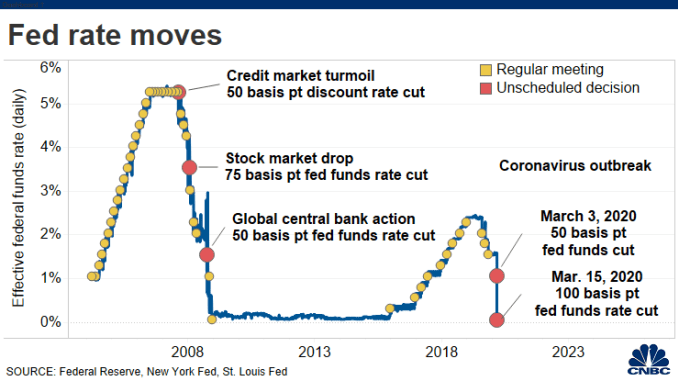In an emergency move Sunday, the Federal Reserve announced it is dropping its benchmark interest rate to zero and launching a new round of quantitative easing.
The QE program will entail $700 billion worth of asset purchases entailing Treasurys and mortgage-backed securities.
Markets responded negatively, with Dow futures pointing to a drop of 900 points when the market opens Monday morning.
The Federal Reserve, saying “the coronavirus outbreak has harmed communities and disrupted economic activity in many countries, including the United States,” cut interest rates to essentially zero on Sunday and launched a massive $700 billion quantitative easing program to shelter the economy from the effects of the virus.
The new fed funds rate, used as a benchmark both for short-term lending for financial institutions and as a peg to many consumer rates, will now be targeted at 0% to 0.25% down from a previous target range of 1% to 1.25%.
Facing highly disrupted financial markets, the Fed also slashed the rate of emergency lending at the discount window for banks by 125 basis points to 0.25%, and lengthened the term of loans to 90 days.
At a press conference Sunday evening following the decision, Powell said the Fed would be patient before lifting rates again.
“We will maintain the rate at this level until we’re confident that the economy has weathered recent events and is on track to achieve our maximum employment and price stability goals,” Powell said.
“That’s the test ... some things have to happen before we consider ... we’re going to be watching, and willing to be patient, certainly,” he added.
The quantitative easing will take the form of $500 billion of Treasurys and $200 billion of agency-backed mortgage securities. The Fed said the purchases will begin Monday with a $40 billion installment.
Cleveland Fed President Loretta Mester was the lone no vote, preferring to set rates at 0.5% to 0.75%, which would have represented a 50 basis point, of half percentage point, reduction.
The Fed added in its statement that it “is prepared to use its full range of tools to support the flow of credit to households and businesses and thereby promote its maximum employment and price stability goals.”
It appeared, though it was not entirely clear, that the meeting that took place will replace the regularly scheduled meeting of the Federal Open Market Committee.
The move follows several actions by the Fed over the past two weeks in which it enacted a 50 basis point emergency rate cut and expanded the overnight credit offering, or repo, for the financial system up to $1.5 trillion.
—CNBC’s Jeff Cox contributed.












Fed rate is settled as of now!
ReplyDeleteNot a surprised move. Been waiting for a awhile for this to happen again!
ReplyDeleteCovid-19 is just a trigger. Oil plunge double whammy trigger.
The most undesirable is currency crisis.
Expect deflationary market, followed by inflation and hyperinflation if currency crisis takes place
Mike Maloney;
ReplyDeleteFirst the threat of deflation, followed by a helicopter drop, followed by big inflation, followed by real deflation, and then followed by hyperinflation.”